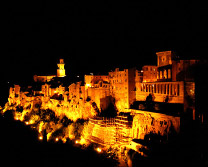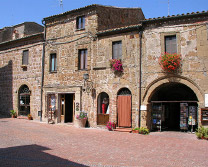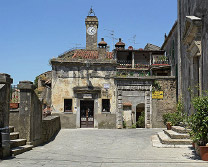B&B Predio San Fernando

The Cities of Tuff
Sacred paths, burial grounds, and ancient cities carved out of rock. Tuff (from the Italian "tufo") is a soft reddish colored rock especially common in Italy and, in particular, in the area of central Italy where the regions of Lazio, Umbria and Tuscany meet. Consisting of consolidated volcanic ash ejected from vents during a volcanic eruption, tuff is relatively easy to cut and its presence in the land which later became known as Etruria favored human settlement here from the Iron age right up to the arrival of the Etruscans, who built both major cities and complex necropolises here.
Sorano, Sovana and Pitigliano feature high on the list of the architectural jewels of "Tuff Maremma". The origins of the towns date back to the Etruscan period, as testified by a number of impressive burial grounds discovered here.
The Archaeological Park "Città del Tufo" in Sovana, explores the changing relationship between the natural landscape and man over time. The necropolises were built on the tuff ridges which follow the course of the area's rivers. Today they are often surrounded by dense vegetation, which suddenly opens up to reveal monumental tombs such as the Ildebranda and Sirena.
Heading into the Mediterranean scrub, visitors discover a series of sunken pathways cut in to the tuff rock. It is thought that these via cave or tagliate passageways, which can reach a depth of up to 20 meters and a width of circa 3 meters, were excavated by the Etruscans as part of a complex defence strategy. The sunken paths are considered sacred because they created a line of communication between the burial grounds and other places of worship.
A visit to the Alberto Manzi Open Air Museum in Pitigliano is, perhaps, one of the best ways to learn about the fascinating history of the Etruscans. The museum is divided into two sections: the "city of the living" and the "city of the dead", linked by the "via cava" of Gradone.
In each city, visitors can observe both typical dwellings and an "explanatory" tomb, illustrating the life led by the past inhabitants and their poignant journey into the after life.
In Tuscia Viterbese, perched perilously on a spur of rock, between the river Tiber and the Bolsena Lake, we find Civita di Bagnoregio. A victim of the unstoppable forces of erosion and destined, sooner or later, to crumble into the valley lying beneath it (the spur of tuff to which the town clings erodes at a rate of circa 7cm a year), Cività di Bagnoregio is often referred to as the dying city. Now home to just fifty houses, a cathedral, and an eerie silence which lingers in the abandoned streets, Cività di Bagnoregio was once a lively and prosperous town.
Today's population is made up of just ten fearless stalwarts, occasionally augmented by the arrival of those intellectuals and artists who have elected Civita di Bagnoregio as their preferred spiritual retreat. The town dominates the Calanchi Valley where the area's rivers, the rain, and the wind have all feasted on the tuff cliffs, creating a lunar landscape of deep ravines, sudden chasms and vertiginous precipices.



